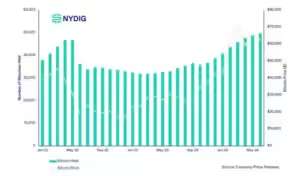Bitcoin Tumbles Toward $62K as Crypto Bulls See $150M in Liquidation

Quick Take
- Bitcoin and other major cryptocurrencies experienced significant drops.
- Over $150 million in bullish bets were liquidated.
- Major contributing factors include large sales by Bitcoin miners and movements by the German government.
- Bitcoin lost 3%, Ethereum, Cardano, and Solana also saw significant declines.
- The CoinDesk 20 index fell by just over 4%.
Bitcoin’s recent price decline has alarmed the crypto market, with the flagship cryptocurrency plunging toward $62,000. This downturn has been marked by substantial liquidations, amounting to over $150 million in bullish bets. As traders and investors assess the causes behind this drop, it becomes evident that several factors have converged to influence this sharp decline.
In the past 24 hours, major cryptocurrencies have experienced notable losses. Bitcoin (BTC) itself shed 3% of its value, reversing gains from the previous week. This decline in Bitcoin’s price cascaded through the market, impacting other significant tokens such as Ethereum (ETH), Cardano (ADA), and BNB Chain’s BNB. Solana (SOL) saw a more severe drop of 7%, trading around $120 by Monday morning. Even popular meme coins like Dogecoin (DOGE) and Shiba Inu (SHIB) were not spared, each dropping nearly 5%.
The CoinDesk 20 (CD20) index, which tracks major tokens excluding stablecoins, mirrored this downturn with a 4% slump. This index serves as a barometer for the broader crypto market, and its decline reflects the widespread impact of Bitcoin’s fall.
The liquidations of bullish bets—positions anticipating higher prices—amounted to more than $150 million over the weekend. These liquidations occur when exchanges forcefully close leveraged positions due to partial or total loss of the trader’s initial margin. In contrast, bearish positions, or shorts, experienced relatively minor losses of $9 million.
Several key factors contributed to this liquidation event. Large sales from Bitcoin miners were a significant driver. Miners, facing increased operational costs and higher breakeven prices following the recent halving, have been compelled to sell their Bitcoin holdings. This selling pressure has intensified, leading to a significant reduction in miner BTC holdings. According to Singapore-based QCP Capital, miner BTC reserves have dropped to their lowest levels in 14 years, decreasing by 50,000 BTC since the start of the year.
In addition to miner sales, the German government’s movements in the Bitcoin market have also influenced prices. The German Federal Criminal Police Office (BKA), which seized nearly 50,000 BTC from a piracy site in 2013, recently started transferring tens of millions of dollars worth of BTC to exchanges like Coinbase and Kraken. This sudden influx of a large supply of Bitcoin into the market has spooked investors, adding to the selling pressure.
QCP Capital commented on this development in a Telegram broadcast over the weekend, stating, “The market has also been spooked by the emergence of a new large pool of supply. The German government allegedly sold around 3,000 BTC in the last few days with 47,000 more to go.” This large-scale movement of Bitcoin has raised concerns about further price declines if the sales continue.
Bitcoin whales, or entities holding significant amounts of Bitcoin, have also contributed to the bearish sentiment. These whales sold over $1 billion worth of BTC in the first two weeks of June alone. The timing of these sales, alongside the actions of miners and the German government, has created a perfect storm of selling pressure in the market.
The broader market sentiment has been negatively influenced by these movements. The rapid sale of large quantities of Bitcoin by different entities has created a reactive environment where traders and investors are quick to liquidate positions to avoid further losses. This reactionary behavior has exacerbated the price decline, leading to a more pronounced market downturn.
Despite the current bearish trend, some analysts believe that the market may find support in upcoming economic events. The U.S. election and Consumer Price Index (CPI) data could provide bullish factors later in the year. If the CPI data shows that inflation is under control, it may reduce concerns about aggressive interest rate hikes by the Federal Reserve, potentially creating a more favorable environment for risk assets like cryptocurrencies.
However, in the short term, the market remains under pressure. The combination of miner sales, large-scale Bitcoin movements by the German government, and significant liquidations have created a challenging environment for Bitcoin and other cryptocurrencies. Traders and investors will need to navigate this volatility carefully, keeping an eye on both technical indicators and broader economic developments.
In conclusion, Bitcoin’s tumble toward $62,000 and the liquidation of $150 million in bullish bets highlight the current market’s fragility. The convergence of large sales by miners, movements by the German government, and reactive market sentiment has driven this decline. As the market absorbs these events, the focus will shift to upcoming economic indicators and their potential to influence future price movements. For now, caution remains the watchword for crypto investors navigating this turbulent period.



